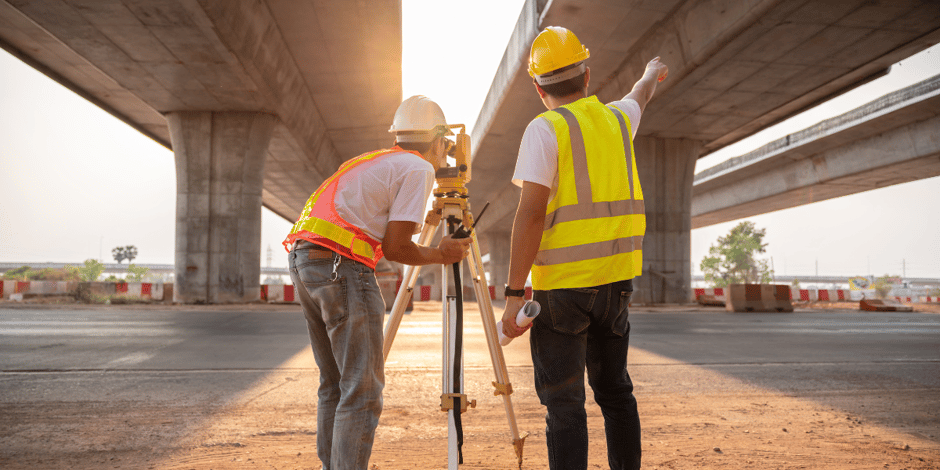5 min read
The Impact of Digital Technologies on Civil Engineering Construction
PES Engineering
Nov 22, 2023

Digitalization has transformed all disciplines, and civil engineering is no exception. Digital technologies have become so vital in construction that adopting them is necessary to leave competitors in the dust.
Check out the 13 innovations that move the needle in construction efficiency, speed and safety.
Building Smarter, Faster and Safer
- Light Detection and Ranging (Lidar)
- Drones
- Computer-Aided Design (CAD)
- Virtual Reality (VR)
- Augmented Reality (AR)
- Internet of Things (IoT)
- Exoskeletons
- Autonomous Construction Vehicles
- Robotic Bricklayers
- 3D Printing
- Digital Twins
- Machine Learning
1. Cloud Computing
The cloud makes data storage, resource access, project management and collaboration among civil engineers painless. Mobile technology makes information sharing incredibly cheap and instantaneous. Cloud-based programs are today’s standard, for they help all professionals working on complex construction projects be on the same page, use agile methods to excellent effect and boost productivity.
2. Light Detection and Ranging (Lidar)
Lidar has made the lives of civil engineers easier in various ways. This laser-based sensing method dramatically improves your ability to measure physical environment surfaces accurately. It lets you plan projects using the most reliable digital models.
Moreover, lidar enhances structure monitoring. Unlike crude tools, it picks up the tiniest details and enables you to evaluate the structural integrity of aging buildings to safely and swiftly conduct repairs.
3. Drones
These unmanned aerial vehicles democratize lidar scanning. They can house sensors and eliminate the need for handheld devices, airplanes, helicopters and even satellites. Lidar drones can map their surroundings quickly and cheaply, translating into less cost and greater productivity.
You can deploy camera-equipped lidar drones to sweep car accident scenes to assist first responders and accelerate cleanup. These vehicles can supply you with accurate and neutral information for accident reconstruction, which helps identify the cause of collision.
4. Computer-Aided Design (CAD)
CAD programs like AutoCAD Civil 3D streamline construction documentation. They have valuable features for producing innovative designs in great detail, presenting creations smoothly and facilitating collaboration for optimal building information modeling.
5. Virtual Reality (VR)
VR takes project visualization to new heights when combined with three-dimensional (3D) modeling. Researchers at the University of Lisbon found VR is useful for spotting building plan anomalies in a virtual environment.
A University of Texas at Arlington civil engineering professor received funding from the Texas Department of Transportation to develop simulations promoting safer work-zone environments. Sharareh Kermanshachi’s project aims to help prepare specialists like field engineers for real-world scenarios minus the risks. The goal is to reduce workplace accidents arising from human errors and improve the health and safety of everyone on-site.
6. Augmented Reality (AR)
AR lets you rely less on imagination to visualize infrastructure elements to determine their fitness and functionality in intended environments. This tech translates complicated architectural drawings into colorful perspectives, aiding marketing.
Likewise, AR nurtures spatial intelligence to reduce waste, spot design errors, minimize construction blunders and maximize labor. It fosters collaboration with simpler “as-planned” and “as-built” project state comparisons.
7. Internet of Things (IoT)
Tech-savvy civil engineers leverage IoT devices to build smart cities, manage construction projects efficiently in real time and mitigate site disasters. They can also monitor the health of structures, perform nondestructive tests and detect damage swiftly. IoT-enabled wearables and sensors power automated construction solutions, too.
8. Exoskeletons
These wearables can minimize manual labor-associated strain and enhance human performance. Their biggest beneficiaries are construction professionals who regularly:
- Wield heavy tools above the head
- Stoop down and lift hefty materials
- Carry out overhead tasks like cutting, drilling and grinding
Exoskeletons, also called exosuits, reduce stress in specific body parts. For example, the Chairless Chair redistributes weight from knees and legs to ease standing and crouching.
Some of this cutting-edge construction gear has sensors to collect usage data, adapt to their wearers and generate ergonomic risk reports. These IoT devices connect to the internet via Wi-Fi or mobile data to store information in the cloud, which will then be accessible on companion apps for analysis and insight.
9. Autonomous Construction Vehicles
Autonomous rovers scan sites to document construction progress with 360-degree imagery and compare observations against digital information to ensure everything is on schedule. They’re powered by the same tech Google driverless cars use, note errors and alert leadership to nip causes of delay in the bud.
In the air, autonomous drones survey the terrain and produce 3D drawings to help civil engineers better understand the area. These vehicles can help you estimate the amount of earthworks you need to move.
What’s more, remotely operated earthmovers will roam construction sites sooner than you think. Retrofitting semi-autonomous capabilities to suitable wheel and track loaders and dump trucks is commercially viable now.
On top of that, the sophisticated hardware making it happen is compatible with various makes. It can quickly go mainstream shortly.
One operator can remotely control multiple semi-autonomous machines, shuttle material around the site, and handle the loading and unloading process from a central command center. This autonomous tech has the potential to eliminate workplace accidents. It can also offset the operator shortage and tap underutilized construction assets to increase productivity.
10. Robotic Bricklayers
Semi-automated masonry systems are tomorrow’s assistant masons. These robots can automate the bricklaying process with precision and efficiency. They spare human workers from strenuous, repetitive tasks. The mason’s still part of the job — ensuring accurate brick placement, excess mortar removal and project completion.
11. 3D Printing
3D printers represent the most promising mode of bridge construction. These machines’ robotic arms can build structures in different materials. The concrete pedestrian bridge in Beijing, the steel bicycle bridge in Amsterdam, and the fiber-reinforced footbridge in Madrid are shining examples. 3D-printed bridges have complex shapes, making it possible to bring intricate designs deemed too impractical for human workers in the past to life.
Furthermore, 3D printers can finish the job efficiently and minimize material waste. They spell faster project completion dates and more savings for construction companies. More importantly, they can reduce pollution — a sustainable solution for the industry responsible for more than one-quarter of the world’s greenhouse gas emissions.
These machines can also simplify road maintenance. When optimized to work with asphalt and tar, they can fix dilapidated streets without causing bottlenecks and inconveniencing the public.
12. Digital Twins
These digital replicas of infrastructure assets disrupt site inspection and maintenance for the better. They can give you a holistic view of a structure or a facility and reveal causes for concern like surface-level defects — just like how informatics sheds light on heavy equipment issues.
Drone- and lidar-scanned digital twins reside in the cloud, so they can chronicle the condition of assets over time and give inspectors historical data on tap. The insights you can glean from digital twins empower you to perform proactive maintenance.
13. Machine Learning
Machine learning algorithms can crunch the numbers on your behalf. They solve complex mathematical problems so you can reserve your bandwidth for more important matters. You can count on these tools to complete designs and plan tasks since they train themselves.
Like other forms of artificial intelligence (AI), machine learning is prone to algorithmic bias. Be careful with the data sets you feed your AI tools with to get reliable output consistently. One of the hurdles you must overcome is building an extensive database with uniform annotation rules to ensure quality acquisition.
Digital Tech Is Constructing Civil Engineering’s Future
These innovations have been positively impactful on construction teams, but they’re just scratching the surface of what’s possible with civil engineering. It’s exciting to see what the field will look like when nascent digital technologies mature.
Civil Engineering experts at PES
When it comes to exceptional civil engineering services, PES stands out as an industry leader. Our multidisciplinary team of highly skilled Civil Engineers and Designers excels in bringing your engineering visions to life, from initial concept to final product.
Our team leverages cutting-edge technology and innovative design solutions to meet your project requirements, ensuring quality, efficiency, and reliability every step of the way. Don't hesitate to Contact Us for your next project, and experience firsthand the unparalleled engineering services that set PES apart.
About Practical Engineering Solutions
Practical Engineering Solutions will always be dedicated to providing top-notch customer service to meet our industry demands. We set ourselves apart with our consistency and timely turnarounds. We are always committed to being responsive to our clients, KEEPING OUR PROMISES, making delivery schedules, and standing by our designs!
From concept, design, and engineering, to project management and integrity services. We are your gateway to your journey's engineering endeavors. Including oil & gas, hemp & CBD, and food industries.
Providing services focusing in Facilities Engineering, Turn-Key Solutions, Hemp Facilities, Food Plant Engineering, Manufacturing, Engineering Services, Drafting & Design, and Inspection Services.




